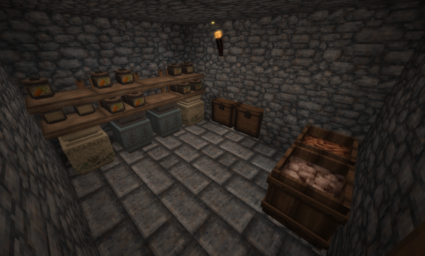Food preservation/ja: Difference between revisions
(Created page with "他の塩漬けのアイテムと異なり、塩漬けの大豆は早く腐敗します。しかし未加工の大豆とは異なり、調理せずに食べるこ...") |
(Created page with "== 食料貯蔵の方法 == 食料にはさまざまな素材が含まれるため、種類やカテゴリーごとに保存方法が異なります。ほとんどの食品...") |
||
| Line 48: | Line 48: | ||
他の塩漬けのアイテムと異なり、塩漬けの大豆は早く腐敗します。しかし未加工の大豆とは異なり、[[cooking|調理]]せずに食べることができます。 | 他の塩漬けのアイテムと異なり、塩漬けの大豆は早く腐敗します。しかし未加工の大豆とは異なり、[[cooking|調理]]せずに食べることができます。 | ||
== | == 食料貯蔵の方法 == | ||
食料にはさまざまな素材が含まれるため、種類やカテゴリーごとに保存方法が異なります。ほとんどの食品は調理して保存することができますが、すべての食品を調理して保存するのは現実的ではありません。 | |||
=== Salt Curing (Preserving Meats) === | === Salt Curing (Preserving Meats) === | ||
Revision as of 15:18, 19 September 2021
バージョン1.10から、食料は時間が経つと腐って腐敗物になるようになりました。食料を確保するためのメカニクスとして保存方法や保存容器、地下室などを紹介します。
食料の腐敗に影響する要素
気候
食料が保存されている場所の気候が、食料の腐敗速度に影響を与えます。暑い気候では腐敗率が2.5倍(250%)まで上昇しますが、非常に寒い気候では腐敗率が0.1倍(10%)まで低下します。海面における気候のみが考慮されるため、山の高い場所に食料を置いても、その山が暑い気候にあれば効果がありません。
。
しかし貯蔵室を作れば、気候の影響を完全に排除することができます。
食料のタイプ
食料の種類によって保存期間が異なります。食品の鮮度が100%保たれる期間は決まっています(下表参照)。この期間を過ぎると保存容器や保存場所、気候条件などの影響を受けて、腐敗し始めます。腐敗が進むと栄養が失われ、最終的には「腐敗物」になります。
| 食料 | 鮮度が保たれる時間 |
|---|---|
| 生肉 | 36 |
| 調理した肉 | 120 |
| 塩漬けの肉 | 8760 |
| 野菜 | 504 |
| カボチャ | 216 |
| タマネギ | 672 |
| 焼いたガマの根 | 48 |
| 塩漬けの野菜 | 1800 |
| その他の果物 | 48 |
| クランベリー | 96 |
| 大豆 | 8760 |
| 塩漬けの大豆 | 4320 |
| 穀物 | 2160 |
他の塩漬けのアイテムと異なり、塩漬けの大豆は早く腐敗します。しかし未加工の大豆とは異なり、調理せずに食べることができます。
食料貯蔵の方法
食料にはさまざまな素材が含まれるため、種類やカテゴリーごとに保存方法が異なります。ほとんどの食品は調理して保存することができますが、すべての食品を調理して保存するのは現実的ではありません。
Salt Curing (Preserving Meats)
Curing meats requires a barrel, salt and the raw meat to preserve. Each unit of meat requires two units of salt, i.e. 32 meat = 64 salt. After adding the appropriate ingredients into the input slot of the barrel, the GUI will state the process yield. At this point the barrel must be sealed for 480 hours to complete the curing process.
Pickling (Preserving Vegetables)
Pickling vegetables requires a barrel, a bucket, salt, water, and the vegetables to preserve. Water and salt are mixed in the barrel to make brine before adding the vegetables. Otherwise, the process of pickling is very similar to salt curing. Each vegetable or legume uses one unit of brine and the barrel must remain sealed for 336 hours.
Once the food items are pickled or salt preserved, they can be stored in any stationary container, though storage vessels are best.
Jam (Preserving Berries)
Making jam requires a cooking pot, a bucket, honey, and berries. Berries can be stored by making jam, which is prepared in the cooking pot. See the cooking page for the jam recipe. For longest shelf life, Jam should be stored in a sealed crock.
Cheese (Preserving Milk)
Milk can be turned into cheese by processing it in several steps with pickled vegetables and salt in a barrel.
Food preservation containers
While food can be stored in any stationary container, storage vessels are best for storing grains and vegetables. Storage vessels and crocks are fairly easy to make, requiring only clay. However to increase the shelf life of meats and vegetables, combining preserving methods with containers is best.
Crocks
Up to 4 portions of meals or pickled vegetables can be stored in crocks providing a slight reduction in food decay, which is a good option for short term food storage. For long term storage, sealing the crocks with a lump of fat or beeswax above the crock in the crafting grid reduces decay by a factor of 10. Filled crocks may be carried in player inventories.
For convenience you can build shelves that can hold up to 8 crocks at a time.
Storage Vessels
Any food item can be stored in vessels, which provide storage benefits to preserved foods as well as raw foods. These vessels are good options for short and long term food storage as they reduce decay 75% for veggies and 50% for grains.
Removing the Rot from Bowls, Pots and Crocks
You just need to throw it in water and wait for a few seconds, the rot will float out of the container. For sealed crocks, you need to unseal it first (getting a food portion with a bowl).
Food preservation locations
To negate the impact of a warm climate, build a cellar. Cellars have a fixed temperature of 5°C or colder if the ambient temperature is lower, meaning you will only profit from a cellar if the outside temperature is higher then 8°C in the first place.
Cellars
To maximize the cellar effect when building:
- Build the walls from soil, ceramic, or stone materials.
- Keep door/trapdoor count low. The best is no doors/trapdoors, and instead use dirt or hay as full-block fillers. The less light inviting openings the cellar has, the better - additionally, doors do not count as a soil or stone block and thus lower the efficiency, even if they do not let in sunlight.
- Keep the sun light level inside the cellar low as it can raise the temperature by up to 10°C, thus influencing spoilage rate. Artificial lights like lanterns, torches and oil lamps are fine. Thus, building a cellar under ground can help reduce the sunlight, but it doesn't give a bonus solely on building underground - cellars can be located aboveground, as long as they are save from the sun.
- Cellars should be no larger than 7x7x7 blocks inside. If the room exceeds these dimensions, it will not be recognized as a cellar. Only the direct walls count, the corner rows can be left out without affecting the room recognition.
Once a cellar is created any food items may be placed on a shelf or inside containers. All items stored in the cellar will receive equal food decay reduction. Players can verify the storage benefit by looking at the block info HUD of a shelf or storage container. It will display something like Stored food perish speed: 0.25 - which in this case means food will last 4 times longer.
Keep in mind that spoilage rates in a cellar might actually vary from block to block, if there is sunlight reaching the cellar in some way.
Effect stacking
Food preservation benefits from methods, containers, and locations stack, so it is best to combine as many preservation solutions as possible. Generally, all food should be stored in a cellar.
| {{{title}}} | |
|---|---|
